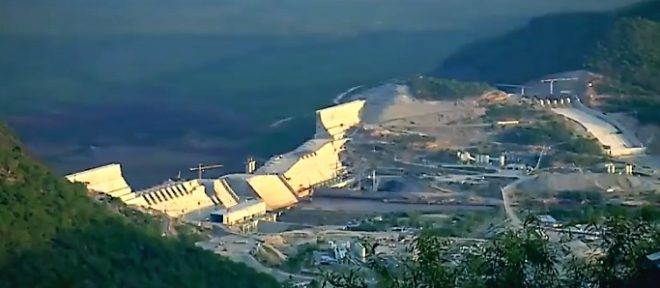Operating the Grand Ethiopian Renaissance Dam
Opinion
By Fewesegn Abay
Ethiopia, Sudan and Egypt are currently negotiating how to fill and operate the Grand Ethiopian Renaissance Dam (GERD). Although technically speaking the issues are not that difficult to resolve, the three countries seem to have difficulties coming to an agreement.
First and foremost, the agreement needs to be based on facts and facts only. And second, it is very important to take into consideration the needs of all countries involved if the agreement is going to be something that they can all live with. Any agreement that favors one country over another will never stand the test of time. History has shown us that agreements that do not stand the test of time will result in unnecessary atrocities and destruction.
Historical Examples
History is full of examples of what could happen if an agreement doesn’t take into account the needs of all involved into consideration. One doesn’t have to look far to see what happens when there is injustice. Many countries around the world have suffered from such systems and one-sided agreements and they’ve paid dearly with the lives of their people. African countries, for instance, were and are still paying the price of colonialism. Their resources were looted, their boundaries were decided by the colonizers and they were left with agreements that were biased and unjust. This has given rise to starvation, civil wars and genocide. The constant suffering has also hampered the development of African countries.
The current problem in reaching to an agreement has its roots in another unjust agreement that favors Egypt and Sudan at the expense of other African countries. The injustice has resulted in instability, instigated by Egypt, in upstream countries. It has also caused death of millions of Ethiopians from drought while the Nile waters, flowing out of Ethiopia, were being used wastefully in Egypt.
In my previous article: *“The Nile is a Shared Resource”, I tried to clearly show that Egypt was wasting about 25 billion cubic meters of water each year, just 1% of this wastage could have saved the lives of over a million Ethiopians who died from a drought driven starvation in 1984.
That’s why it is very important that the three countries shouldn’t enter into an agreement that could cause pain and suffering to their descendants. Each country should see all the descendants of all the countries of the basin as their descendants.
I will try to address here what an evidence based agreement should look like and how long this agreement should last. This article’s main focus is on the agreement on the operation of the Ethiopian Dam.
Grand Ethiopian Renaissance Dam (GERD)
The Grand Ethiopian Renaissance Dam (GERD) is a hydroelectric dam currently being built on the Abay River (Blue Nile) near the Sudanese border. When completed, it will have a capacity to store 70 billion cubic meters of water and generate up to 15,128 Gigawatt hours (GWh) of electricity. The Dam will be used strictly to generate electricity and the water will flow down the river once it has generated electricity. Even though the Dam doesn’t consume water, Egypt is worried and claims that it will create loss of its “share” (55 million cubic meters) of the Nile waters.
Although the three countries have been negotiating the operation of this dam for over 9 years now, they have not come to an agreement on how to fill the Dam or how to operate it. The failure to come to an agreement was not due to the complexity of the operation of the Dam but by the interest of Egyptian negotiators trying to add conditions that are not related to filling and running the Dam into the agreement
.
Evidence based agreement
According to the Food and Agriculture Organization (FAO) of the United Nations, the average annual flow of the Nile River at Dongola, Sudan from 1890 to 1995 was 84.1 billion cubic meters. This is the amount of water that flows into Lake Nasser in Egypt. Out of this, Egypt claims it uses 55 billion cubic meters and evaporation removes another 10 billion cubic meters. On average around 19.1 billion cubic meters of water flows into the Mediterranean Sea every year. The average amount of water that Lake Nasser gets from Abay River, averaged over 1912-1997 is 48.7 billion cubic meters. During heavy rainy seasons, Lake Nasser gets a lot more water but the excess flows into the Mediterranean Sea. During droughts, Lake Nasser might not get enough water and Egypt has to compensate for the loss using excess water stored in the Lake.
How will the Ethiopian Dam affect the flow into Lake Nasser? To simplify the computation, let us assume that the Ethiopian Dam will not generate electricity and that it is the only change to the drainage basin. Every year there is heavy rain, the Ethiopian Dam will just harvest, on average 19.1 billion cubic meters and during drought it will just keep the water that it has already harvested and release all the water that comes in. The water in the Ethiopian Dam is thus water that flows into the Mediterranean Sea. If the average flow remains the same, the Ethiopian Dam could harvest, on average, about 19.1 billion cubic meters each year and fill up in about 4 years without affecting the capacity of Lake Nasser to provide 55 billion cubic meters of water. Having harvested the maximum amount of water that it could, how much water should the Ethiopian Dam release downstream?
A mathematician was once asked how he will boil tea if there are tea bags in the drawer, cups in the cupboard and a kettle on the counter. He indicated that he will pick up the kettle, add water to it, boil the water, get a tea bag from the cupboard and pour the water over the tea bag into the cup. The problem was then changed, this time with the kettle being on the ground. The mathematician indicated that he will pick up the kettle and put it on the counter. He then indicated he has already solved this problem.
We will use the mathematician’s approach to figure out what the yearly flow from Abay River should be. The water in the Ethiopian Dam is water that would have ended up in the Mediterranean Sea. So let us remove the Ethiopian dam with all the water that it stored from the Abay River. Without the dam, the water flows unimpeded and Lake Nasser just gets the amount of water that it would get if the Ethiopian Dam was not there. Since the Ethiopian Dam doesn’t consume water, if we now put the Dam back into the picture, it will release all the water that comes into the reservoir as if the Dam isn’t there.
Ethiopia believes that it could fill the Dam in 4 to 7 years while Egypt thinks that in the worst case, it could take 20 years. In light of the discussion above, the agreement on how to fill and operate the Dam need only be an agreement that lasts from 4 to 20 years. Once we reach the point where the Ethiopian Dam fills up with the excess water, there is no more need for an agreement. Since the Ethiopian Dam just holds water that would have ended up in the Mediterranean, it will not affect the flow of the Abay River.
So far the assumption is that the Ethiopian Dam will just store water but this is not the case when the Dam is used to generate electricity. Let us now fill the Ethiopian Dam and use it to generate electricity when possible. Until the Dam reaches the point where the Ethiopian Dam fills up and Lake Nasser stores 65 billion cubic meters above dead storage at the same time, anywhere from 3 to 20 years, the Ethiopian Dam will harvest all the water coming in while releasing 2.5 billion cubic meters of water each month. Assuming an average flow of 48.7 billion cubic meters at the Ethiopian Dam, by October of the first harvesting year the Ethiopian Dam will contain about 29 billion cubic meters and by the beginning of the next rainy season 18.7 billion cubic meters. Over the year, Lake Nasser will be able to release 55 billion cubic meters and achieve its usual level at the beginning of the next rainy season. Year 2 the Ethiopian dam will have about 58 billion cubic meters at the end of the rainy season and 35 billion cubic meters at the beginning of the next rainy season.
After 4 years of average flow, the Ethiopian Dam will fill up with water that would have ended up in the Mediterranean and Lake Nasser will contain 65 billion cubic meters about the dead level at the end of the rainy season. At this point in time, the water in the Ethiopian Dam is water that would have ended up in the Mediterranean Sea. Normal operation at the Ethiopian Dam will result in an increase in the amount of usable water in the drainage basin. At the beginning of the rainy season the Egyptian Dam will have extra water, because of the Ethiopian Dam, enabling Egypt to withstand droughts better. In light of this fact, a win-win situation created by the existence of the Ethiopian Dam, one wonders why Egypt will be strongly opposed to it.
In conclusion:
This article is not about how the Nile water should be shared. It just uses current claims to show what the Dam filling agreement should look like and how it is beneficial for the drainage basin.
The Ethiopian Dam could be filled up in 4 to 20 years while at the same time generating electricity. The agreement thus needs to be an agreement that lasts anywhere from 4 to 20 years only. The amount of rain in the Ethiopian highlands will determine how long it takes.
______________________________________________________________________________________________________________________
Disclaimer: The views & opinions expressed in this article are those of the author and not necessarily represent any official policy or position of Ethiosports. Furthermore, Ethiosports does not make any representation nor is responsible to the accuracy or completeness of any information in this article.





1 thought on “Operating the Grand Ethiopian Renaissance Dam”
Comments are closed.